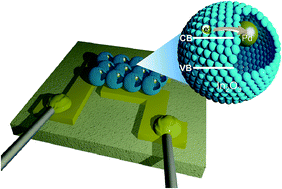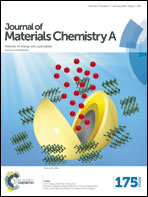Role of Pd nanoparticles in gas sensing behaviour of Pd@In2O3 yolk–shell nanoreactors†
Abstract
Pd@In2O3 yolk–shell nanoparticles (NPs) were synthesized by a simple solution route using Pd@C core–shell NPs as template and applied for gas sensing. A glucose-assisted hydrothermal method was used for the synthesis of Pd@C core–shell NPs. Pd@In2O3 yolk–shell NPs were formed after calcination (450 °C for 3h) of Pd@C core–shell NPs containing indium precursor. In the Pd@In2O3 yolk–shell geometry, about 50–70 nm Pd NPs were present at the periphery of an In2O3 shell (10–20 nm thickness). The In2O3 shell was composed of ∼10 nm primary particles. The role of Pd NPs in gas sensing behavior of In2O3 has been investigated. The loading of In2O3 with Pd NPs improved the response for reducing gases, but reduced the response for oxidizing gases. The response of Pd@In2O3 yolk–shell NPs to ethanol was approximately 14 times higher than that of pure In2O3 hollow nanospheres at 350 °C. However, no response was recorded for NO2 for Pd@In2O3 as compared to In2O3 (resistance ratio Rs = 2.50) at 350 °C. The maximum response of Pd@In2O3 yolk–shell NPs to 5 ppm ethanol was 159.02 at 350 °C, which was approximately 2.5 times higher than those for other interfering gases (NO2, p-xylene, trimethylamine, HCHO, CO and H2). The effect of humidity on the gas sensing characteristics of Pd@In2O3 yolk–shell NPs suggested that the present sensor can be used to detect ppm-level ethanol even in highly humid atmosphere (80% RH). The improved gas sensing performance of Pd@In2O3 yolk–shell NPs was attributed to catalytic activity of Pd NPs as well as hollow spaces that allowed the accessibility of Pd NPs to gas molecules.


 Please wait while we load your content...
Please wait while we load your content...